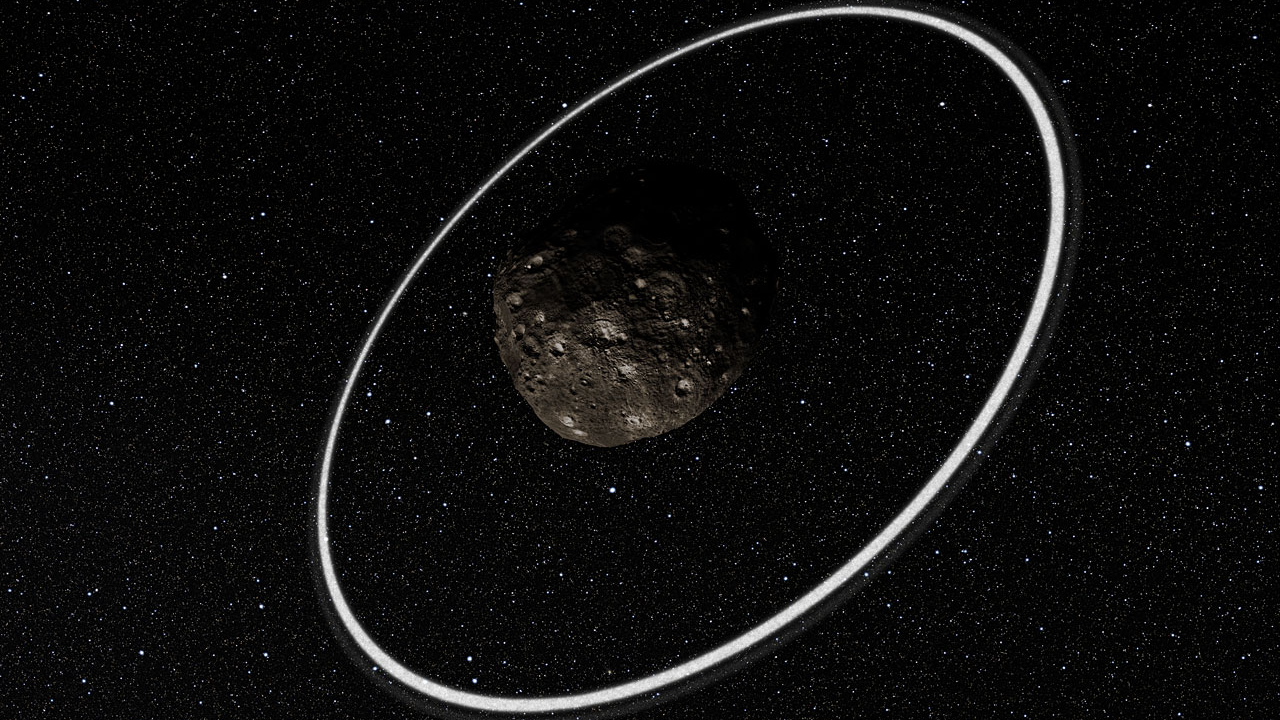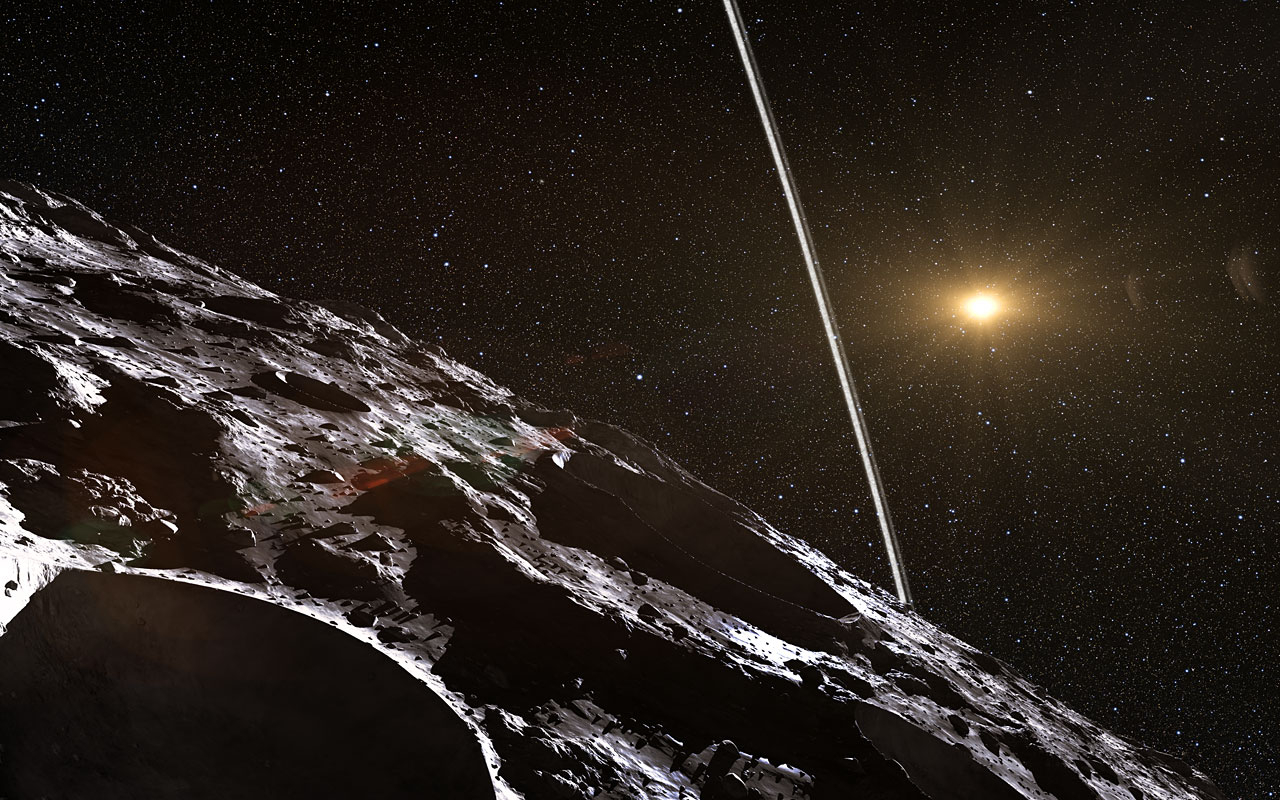Hidden moon may hold together rings of strange comet-like object between Jupiter and Neptune
The narrow rings around Chariklo, which is the largest known Centaur, could be maintained by an unseen moonlet.

A little moonlet, too small to be seen from Earth, could be playing cosmic sheepdog by shaping the thin rings around the distant minor planet Chariklo, according to new computer simulations.
Chariklo is a Centaur — a breed of small body that orbits the sun on a path sandwiched somewhere between Jupiter and Neptune. Centaurs are thought to come in from the Oort Cloud, which is a vast halo of trillions of frozen cometary bodies that extends possibly a light-year from the sun. Over the course of millions of years, they drift inward, either to be ejected from the solar system by the gravity of the giant planets, or to transition into Jupiter-family comets — comets with orbital periods of less than 20 years that are governed by the gravity of mighty Jupiter.
At about 155 miles (250 kilometers) in diameter, Chariklo is the largest known Centaur. In 2013, Chariklo was seen to pass in front of a distant star from our point of view, causing the star's light to wink out briefly. Observations showed that not only did the solid body of Chariklo block the light, but so too did a pair of thin rings around the Centaur. Stellar occultations have shown that another Centaur, Chiron, also has rings, although they do not seem entirely stable.
Related: Centaur Chariklo has rings: Images of a space rock oddity (gallery)
"Rings around minor planets have only been recently discovered, and only a small number of such systems are currently known," Amanda Sickafoose, a senior scientist at the Planetary Science Institute in Arizona, said in a press statement.
Chariklo's two rings are located about 243 miles and 252 miles (391 and 405 km), respectively, from the center of Chariklo, although measurements can vary slightly. The rings themselves are narrow, just 4.3 miles and 1.9 miles (7 and 3 km) wide.
These rings are not like the rings of the giant planets, which are retained by the gravity of such huge worlds. Computer models show that Chariklo's rings should be short-lived, and that they should widen and then disperse. So what's keeping them in place?
Get the Space.com Newsletter
Breaking space news, the latest updates on rocket launches, skywatching events and more!
Sickafoose and Mark Lewis, a computer scientist at Trinity University in San Antonio, performed N-body computer simulations of the rings made up from millions of particles, and showed that the influence of a small moonlet could keep the rings narrow and prevent them from dispersing.
"We've shown that one of the possibilities for thin rings to exist around small bodies is that they are being sculpted by a small satellite," Sickafoose said.
Shepherd moons are nothing new; all the gas giant planets have them, most notably Saturn, where the tiny moons Daphnis, Epimetheus, Janus, Pan and Prometheus carve gaps in Saturn's rings and then herd the ring material to keep it tidy.

Chariklo's shepherd moon, if it existsl, would be about 1.9 miles (3 km) across and contain a mass on the order of 10 trillion kilograms (about 22 trillion pounds here on Earth). Although it is too small to be directly observed from Earth at Chariklo's distance — the Centaur's elongated orbit gets as close to the sun as 1.2 billion miles (1.9 billion km) and as far away as 1.7 billion miles (2.8 billion km) — its presence could be detected during stellar occultations.
There is one other possible explanation for the rings' staying power. If we suppose that a gravitational anomaly exists within Chariklo — a denser part of rock, for example — then gravitational resonances between the rings and the anomaly could help tie the rings down. The rings do orbit in a nearly 1:3 resonance with the Centaur, meaning that Chariklo rotates three times (once every seven hours) for every one rotation of the rings. However, the rings are also placed suspiciously close to the Roche limit. This is the distance from a central body within which gravity prevents particles from accreting into a moon. Being right on the edge of this limit means that the ring particles should be able to start sticking together to build a new moon. A shepherd moon's gravity would be able to intervene to prevent this.
"A satellite in this situation can perturb the ring material and prevent it from accreting," said Sickafoose.
Related: Mighty morphin' Centaur rings — a distant icy object's rings are transforming

"We think that the ring particles are primarily made of water ice, like those at the gas giants," said Sickafoose. Indeed, the James Webb Space Telescope detected water-ice there in 2023. However, things that we don't know include how "hard" or "soft" the particles are when they collide, or the distribution of particle sizes in the rings.
It is also unknown how the rings formed in the first place. Have they been outgassed by cryovolcanism on the surface of Chariklo, or are they the remains of a small body that got too close to Chariklo, inside the Roche limit, and was torn apart?
The findings were published on Feb. 6 in The Planetary Science Journal.
Join our Space Forums to keep talking space on the latest missions, night sky and more! And if you have a news tip, correction or comment, let us know at: community@space.com.

Keith Cooper is a freelance science journalist and editor in the United Kingdom, and has a degree in physics and astrophysics from the University of Manchester. He's the author of "The Contact Paradox: Challenging Our Assumptions in the Search for Extraterrestrial Intelligence" (Bloomsbury Sigma, 2020) and has written articles on astronomy, space, physics and astrobiology for a multitude of magazines and websites.
-
rod The 14 page PDF is detailed and another indicator of young ages seen in the solar system, commonly dated some 4.6 Gyr using meteorites ages. Recent catastrophism in the solar system is what such reports look like, Mimas young ocean along with other ring ages like at Jupiter, Saturn, Uranus, and Neptune.Reply
Ref - Numerical Simulations of (10199) Chariklo's Rings with a Resonant Perturber, https://iopscience.iop.org/article/10.3847/PSJ/ad151c, 06-Feb-2024. "Abstract The discovery of two thin rings around the ∼ 250 km sized Centaur Chariklo was the first of its kind, and their formation and evolutionary mechanisms are not well understood. Here, we explore a single shepherd satellite as a mechanism to confine Chariklo's rings. We also investigate the impact of such a perturber on reaccretion, which is a likely process for material located outside the Roche limit...Centaurs are thought to evolve inward from the outer Solar System, and their unstable orbits typically cross those of the giant planets. The dynamical lifetimes of Centaurs are only a few million years, mostly being ejected from the Solar System/entering the Oort cloud or transitioning into Jupiter-family comets (e.g., Tiscareno & Malhotra 2003)...The ring locations and thin widths are keys to understanding the Chariklo system. Over relatively short timescales, <1 Myr, Chariklo's rings should naturally disperse (Braga-Ribas et al. 2014). Goldreich & Tremaine (1979) proposed that narrow, eccentric rings like those at Uranus have apse alignment due to self-gravity. Pan & Wu (2016) built on that idea for Chariklo, developing a simple model that combined the ellipticity of the nucleus and the particles' self-gravity to maintain apse alignment. They determined a mass for the inner ring (a few times 10^16 g) and a spreading time of ∼10^5 yr."
My note, I did not see how long the ring system could last using a shepherd satellite, e.g. from the Conclusion in the paper: "The simulation phase space explored here is not exhaustive, but it does provide representative conditions under which a Chariklo-like ring can be maintained."









